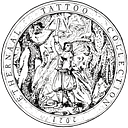The traditional method of tattooing in Japan is called irezumi 入れ墨 (literally meaning ‘to enter the ink’) and it reaches back to 10,000 BC. The tattoos do not involve either stencil or machine, and are made by applying the ink directly to the skin.
The significance of Japanese tattoos has been changing throughout history. In the past, tattoos were used as identification of a person who had committed a crime. Consequently, a person who was marked was kept away from society life and left without job and service.
However, in the Edo period (1603–1867) Japanese tattoo culture flourished. The interest in woodblock print had risen to the extent that people wanted to transfer an admired image to their body. Many woodblock print artists started to practice as tattoo artists. Usually, it was the middle class that would get heavily ornamented full body tattoos. The tattoo was a reference to one’s profession, for example, a firefighter would get a tattoo of a phoenix, to provide protection from fire, like an amulet.
The situation shifted in the Meiji Restoration in 1868, when the shogunate fell down and the country changed entirely. From being ruled under a strict shogunate regime, the country has opened its borders and adapted to the new reality. During this time, Japan was industrialized and Westernized. Further, outside Japan tattoos had a pejorative image, they were tightly connected with the criminal world. Thus, to avoid negative reception, Japan decided to ban tattooing. Although the tradition was still cultivated underground, tattoos were outlawed until the middle of the 20th century. As a consequence, for 30 years tattoos were made illegally, connected to the criminal world, specifically gangs such as Yakuza. The tattoo price was extremely expensive, it included a long process of making and putting attention to the small details.
In this way, the human body became a canvas for a tattoo master’s artwork. Marking the bodies has started to be a significant identification of yakuza’s lifestyle. The illustrations were referencing their status and position inside the gang.
The tattoos were not only made on yakuza members. The crime family would pay to host the artwork on somebody’s body. The value would increase with the years passing by. However, it was a long time to wait for an artwork, that’s why sometimes ‘accidents’ would happen to the host of the tattoo. The evidence can be found in the Jikei Medical University in Tokyo, where a tattooed body is exhibited. It was previously researched that the artwork most probably was hosted in exchange for medical health care throughout host life.
The collectors kept purchasing human canvases on the black market. The most famous bodysuit collector was Doctor Fukushi Masaichi. His morbid obsession towards preserving tattooed skin resulted in opening the exhibition of human body’s in The Medical Pathology Museum at Tokyo University. The museum displays at least 105 pieces of people’s skin, however, the collection is not open to the public. Doctor Masaichi put all his effort into preserving tattoo culture after a person’s death.
Creating Ethernaal, we are driven by a similar aim as Doctor Masaichi. Someone once said that “the greatest art lives forever”, and this is the philosophy of our project. Using recent developments in NFT’s and blockchains, tattoos can be bought and sold through Ethernaal and the artwork will live forever as an NF2T.
Sources: https://troubleandsqueak.com/2015/06/25/japans-black-market-for-tattooed-human-skin/
https://yamatomagazine.home.blog/2020/09/14/the-bodysuit-collector-doctor-fukushi-masaichi/
